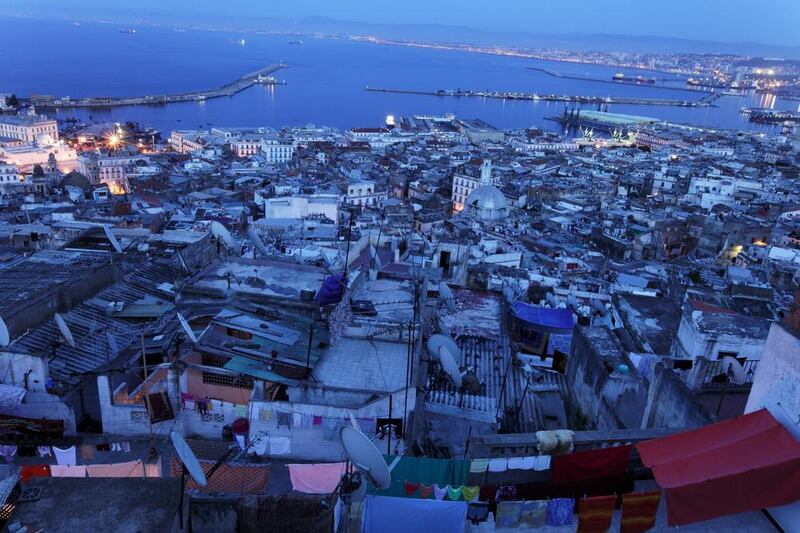The Lamia of ancient Greek mythology was a beautiful Libyan queen and mistress of the god Zeus, who became a snake-like, child-eating monster. In Keats's poem of the same name she is "some demon's mistress, or the demon's self". The protagonist of Boualem Sansal's remarkable novel Harraga is also called Lamia. However, instead of a fantastical vengeful creature, we encounter an unmarried, solitude-loving Algerian paediatrician. Not a mistress but a spinster "deaf to suitors"; not child devourer but childcarer. Over the course of four acts and an epilogue, Sansal packs Lamia's story with more playful tropes, together with regular keen-eyed glances at Algeria's past and present and a steady stream of beautiful and evocative prose.
We learn early on that harraga means “path-burner” in Arabic, a runaway who flees his or her country for a better life elsewhere. Lamia’s brother Sofiane is one; another is his friend Chérifa, a teenage lost soul from the sticks. The novel opens with this stray turning up unannounced on Lamia’s doorstep. Excited to hear news about her errant sibling and shocked to discover her unexpected guest is several months pregnant, Lamia invites Chérifa into her home.
A friendship of sorts develops. Chérifa finds in Lamia the loving parent she never had. Lamia gets from Chérifa respite from the loneliness that blights her days – days spent working flat-out at the hospital or else "entombed" in her ancient, ramshackle house. After rereading Robinson Crusoe – "full of pointers on how to teach savages" – Lamia goes about educating her new companion and charge, showing Chérifa the sights of Algiers, and teaching her to read and appreciate music.
But disaster strikes when one day Chérifa ups and leaves. A bereft and confused Lamia shuttles between frantically scouring the city for her and sinking back into self-imposed reclusiveness. A breakthrough comes in the form of a phone call out of the blue informing her of Chérifa’s whereabouts. Sansal’s final pages constitute a surprisingly gripping climax to a novel that, up until then, prioritises acute observation over tense revelation, more character and less action.
And what character. Lamia is a truly wonderful creation. We witness a variety of her moods, mindsets and impulses: itching to track down the government minister who impregnated, then deserted Chérifa, talking to the ghosts of previous owners in her crumbling mansion, and arguing with the bureaucrats at the Disappeared Association – an institution that could give Dickens’s Circumlocution Office a run for its money. During her bouts of philosophical musing, any inclination towards dull navel-gazing is swiftly muffled by her vibrant cynicism: “Reality is but a port of call on our journey, a succession of mindless chores, repetitive gestures, tedious stories, so we might as well be brief.”
Lamia’s backstory features a happy childhood, which, after a freak tragedy, abruptly gives way to tortured adulthood: “As I stumbled on, I stockpiled sorrows.” She accepts her job at the hospital and claims she has joined “the most reviled mob in the Islamic world, the company of free, independent women”. Her bold thoughts manifest an unchecked single-mindedness: “I learnt all there was to know about the Arab-Islamic economy: at work just like at home, the men chat and the women toil and there’s no rest on Sunday for anyone.” When she rails against “the green plague of Islamofascism” or bewails how “the young people of Algeria are still draining away, the country is like a bathtub that’s sprung a leak” each gutsy statement is backed up with fact, usually born of her own experiences and regrets.
Strong characters and reformulated myths abound but Harraga also owes its energy and identity to fairy tales. Chérifa has run away from a wicked stepmother. A tale-telling student named Scheherazade pops up. Lamia feels she is being watched by a neighbourhood bogeyman she calls Bluebeard. Less successful is Sansal's incorporation of a couple of film synopses (including, perplexingly, that of Gremlins) to draw parallels with his characters, as the comparisons feel forced. And there are sprinklings of verse – Lamia's poetry – which are hard to get worked up about, despite the best efforts of the otherwise redoubtable translator Frank Wynne.
Sansal – whose name has been mentioned in Nobel whisperings – lives and works in his native Algeria despite the fact that his books are banned there. But like Lamia he won't be silenced. His criticism comes via his characters, with Lamia branding Algeria "a Third World country chasing its tail". In Harraga, Sansal offers a stunning portrait of a troubled country and one of its more bowed but unbeaten inhabitants.
Malcolm Forbes is a regular contributor to The Review.
thereview@thenational.ae





